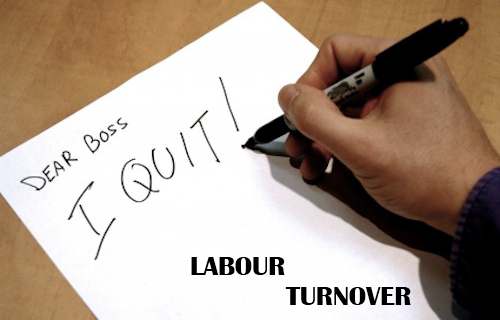Labour turnover | Causes | Effects | Measures to control
Table of Contents
What is Labour Turnover?
In each concern, employees often join and leave the concern for variety of reasons. The relation between the number of persons joining the firm and leaving the same on account of retirement, resignation, Layoff or retrenchment, etc., to the average number of pay roll is termed as Labour Turnover.

Definition of Labour Turnover
Dale Yoder defines labour turnover as,
time to time changes in the composition of the workforce, the result from the hiring, release and replacement of employees.
Labour turnover involves accessions and separations of employees. Accessions means employment of workers, whereas separation involve termination of employment due to lay-offs, deaths, discharges, quits, etc. The rate of separation can be calculated with the help of the following formula:
Labour Turnover Formula = (Total number of workers leaving the organization per month or year / Average number of workers on payroll for a month or year) x 100
This can be illustrated with the help of the following example:
The total number of workers leaving the concern is 500 a year and the average number of workers on the payroll for one year is 5000. The rate of turnover would be:
500/5000 x 100 = 10% per year.
What Causes Labour Turnover
Causes for labour turnover could be classified into two types. They are:
- Unavoidable causes i.e., Natural causes, and
- Avoidable causes.
Unavoidable causes are natural causes are are not under the control of the management. Such causes normally include
1. Change of Locality
2. Death, retirement etc., of workers.
3. Transport or housing problem in the firm’s locality.
4. Unfit for the work.
5. Misconduct of workers.
6. Sickness, accident, etc., of workers.
7. On account of personal betterment.
8. Domestic matter like marriage, etc.
10 Avoidable causes of Labour Turnover
Avoidable causes are the causes that are under the control of the management and are due to the personnel policy of the organization. Such causes are
1. Low wage rates and other allowances when compared to other concerns.
2. Unhealthy and bad working conditions.
3. Lack of job satisfaction due to faulty placement of workers.
4. Heavy work load and long working hours.
5. Absence of sound training programmes.
6. Lack of proper promotion methods.
7. Unsatisfactory medical and recreational facilities.
8. No job security.
9. Ill treatment of management towards the employees.
10. Temporary Job.
Effects of Labour Turnover
Effects of Labour Turnover depends upon the rate of labour turnover. Labour Turnover cannot be eliminated completely. There must be some labour turnover on account of unavoidable causes like retirement, death, etc. But, high rate of Iabour turnover is always unhealthy for the organization due to following reasons:
1. Constant changes in the workforce will affect the continuity of work. As a result, the overall production may be reduced.
2. The amount spent on selection and training of workers leaving the job will go waste. Further, to fill up the vacancies, management has to spend money on selection and training of new workers. It increases the cost of production.
3. New recruit may need sometime to learn the work and adjust himself with the new surroundings which may result in loss of productivity.
4. New recruit may need some time to learn the work and adjust himself with the new surroundings which may result in loss of productivity.
Measures to control Labour Turnover
All organizations expect to hive a certain rate of labour turnover, which is considered normal to that industry and trade. But, when the rate of labour turnover is considered high, then every effect should be made to reduce it.
The following measures may be adopted to minimize the labour turnover.
1. Appointing right man on the right job.
2. Fair and equal treatment of all workers throughout the organization.
3. Improvement of working conditions.
4. Provision of fair wages, allowances and other monetary benefits.
5. Provision of proper training facilities to new as well as existing employees.
6. Provision of medical facilities to protect employees from sickness.
7. Provision of welfare activities.
8. Allowing workers participation in the management.
9. Adopting sound promotion and transfer policies.

